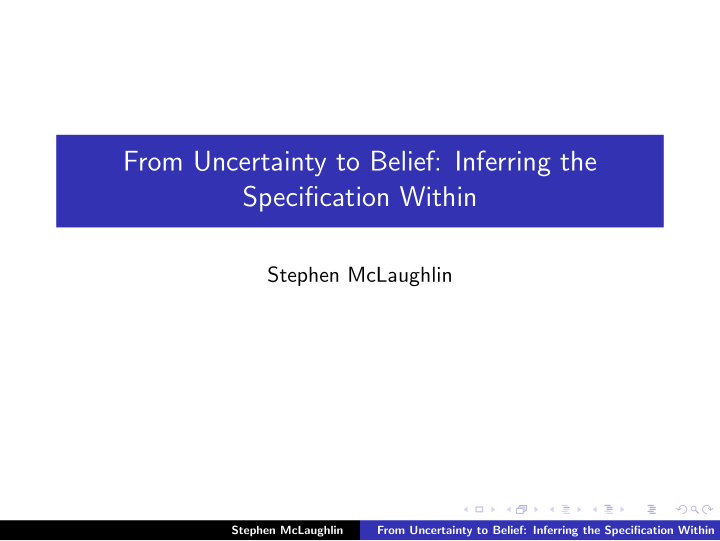



From Uncertainty to Belief: Inferring the Specification Within Stephen McLaughlin Stephen McLaughlin From Uncertainty to Belief: Inferring the Specification Within
Overview ◮ Area: Program analysis and error checking / program specification ◮ Problem: ◮ Tools lack adequate specification. ◮ Good specifications are hard to make. ◮ More specifically, the ownership problem ◮ Solution: Automate some or all of program specification ◮ Methodology: Quasi expert systems approach / implementation Stephen McLaughlin From Uncertainty to Belief: Inferring the Specification Within
Uses of program analysis 1. Basic syntax, convention and common error checking - lint 2. Slightly more advanced error detection, e.g. dereferencing NULL and type checking - splint 3. Formal methods What is the trend moving down this list? Stephen McLaughlin From Uncertainty to Belief: Inferring the Specification Within
Annotations ◮ splint ◮ /*@null@*/ char *c - Forces a check for NULL before every dereference ◮ /*@in@*/ int *i - Forces an actual parameter to be completely defined before being passed to a function ◮ /*@out@*/ int *o - Forces the parameter to be completely defined before the function returns ◮ Java 5.0+ Supports basic pre-defined annotations, as well as some advanced features ◮ Users can define their own annotations, which can themselves be annotated. ◮ A method’s annotations can be obtained at runtime through Java reflection. ◮ @Override someMethod() - Compiler throws an error if the annotated method does not override one in a superclass Stephen McLaughlin From Uncertainty to Belief: Inferring the Specification Within
Specification in this paper ◮ Basic idea: Who is allocating & deallocating memory ◮ Generalized: Who is returning and claiming ownership of resources? ◮ Ownership: A pointer owns a resource if it is the pointer that could currently be used to de-allocate that resource. ◮ Possible annotations for a function are ◮ co - Claims ownership of a resource ◮ ro - Returns ownership ◮ ¬ ro / ¬ co - ? ◮ Assumption? Stephen McLaughlin From Uncertainty to Belief: Inferring the Specification Within
Annotation Variables Syntax: method : ret|formal parameter number Example: FILE *fp = fopen("myfile.txt","r"); fread(buffer, n, 1000, fp); fclose(fp); Stephen McLaughlin From Uncertainty to Belief: Inferring the Specification Within
Annotation Variables fopen:ret ∈ {¬ ro , ro } FILE *fp = fopen("myfile.txt","r"); fread:4 ∈ {¬ co , co } fread(buffer, n, 1000, fp); fclose:1 ∈ {¬ co , co } fclose(fp); Stephen McLaughlin From Uncertainty to Belief: Inferring the Specification Within
Specifications and Factors ◮ A is the set of annotation variables in a program ◮ A = a is an assignment to these variables, that is, a specification ◮ A factor f i is a mapping: ◮ f i : A i → [0 , ∞ ) where A i ⊆ A . ◮ Example: ◮ f FILE ( fopen : ret = ro ) = 0 . 51 and f FILE ( fopen : ret = ¬ ro ) = 0 . 49 ◮ Product of experts ◮ P ( A ) = 1 � f i ∈{ f i } f i ( A ) Z Stephen McLaughlin From Uncertainty to Belief: Inferring the Specification Within
More factors ◮ Prior Factors : ◮ One per annotation variable ◮ Adds a bias to each variable ◮ Check Factors : ◮ Two values that sum to 1 ◮ θ OK and θ BUG ◮ OK or BUG is decided by a FSM ◮ Normally want θ OK > θ BUG ◮ Where does each type of factor come from? Stephen McLaughlin From Uncertainty to Belief: Inferring the Specification Within
Annotation Factor Graph (AFG) The code: 1. FILE * fp1 = fopen("myfile.txt", "r"); 2. FILE * fp2 = fdopen(fd, "w"); 3. fread(buffer, n, 1, fp1); 4. fwrite(buffer, n, 1, fp2); 5. fclose(fp1); 6. fclose(fp2); The graph: Stephen McLaughlin From Uncertainty to Belief: Inferring the Specification Within
Using the graph Stephen McLaughlin From Uncertainty to Belief: Inferring the Specification Within
More inference techniques Multiple Behavioral Tests ◮ Adds new states to FSM used for check factors ◮ Correct States: Deallocator, Ownership, Contra-Ownership ◮ Incorrect States: Leak, Invalid Use ◮ Once again, correct states weighted more heavily than incorrect Naming conventions ◮ Most developers follow a pattern in which functions with similar behaviors or purposes have similar names. ◮ We add an extra factor to each callsite that evaluates to θ � keyword , ( co | ro ) � or θ � keyword , ( ¬ co |¬ ro ) � ◮ Note that developers can influence the accuracy of this factor by choice of keywords. Stephen McLaughlin From Uncertainty to Belief: Inferring the Specification Within
Implementation ◮ Checker observes ◮ All call sites that return pointer ◮ String constants (treated as returned by ¬ ro ) (Why?) ◮ Pointer dereferences (treated as ¬ co ) (Why?) ◮ Note: Model is computationally infeasible, so Gibb’s sampling is used. ◮ Also uses, simulated annealing and false path pruning for AFGs Stephen McLaughlin From Uncertainty to Belief: Inferring the Specification Within
Evaluation Stephen McLaughlin From Uncertainty to Belief: Inferring the Specification Within
Evaluation Three AFGs ◮ Basic AFG - as described earlier ◮ AFG NoFPP - AFG that does no false path pruning ◮ AFG Rename - Renames functions at each callsite to make all function calls unique Stephen McLaughlin From Uncertainty to Belief: Inferring the Specification Within
Stephen McLaughlin From Uncertainty to Belief: Inferring the Specification Within
Take away ◮ Technique works assuming assumption about programming idioms hold ◮ This is often true except in special cases such as the Linux kernel Stephen McLaughlin From Uncertainty to Belief: Inferring the Specification Within
Recommend
More recommend